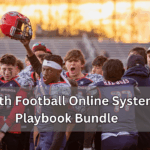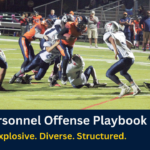Youth Football Online
The Promotion & Instruction of Youth Football
0 items
-$0.00
Home / Inside Zone Wham Series
The Inside Zone wham series play has become prominent throughout Youth, High School, College and Professional football because of its simple rules and versatility.
Blocking Scheme
In the Inside Zone blocking scheme each lineman is responsible for blocking their playside gap and getting vertical movement on the defender in that gap. Each lineman has the rule that if there is not a defender in his playside gap he should help his buddy by double teaming the defender in his backside gap. The effect of these rules is that there are multiple double teams on the line of scrimmage and very few missed assignments. The rule on the offensive line is that defensive lineman makes tackles for loss, linebackers make tackles for 3 yards and defensive backs make tackles for 7 yards. The goal of the Inside Zone Scheme is to block all of the linemen so the offense is guaranteed at least a 3 yard gain.
About the Inside Zone Wham Series
In this inside zone wham series we will use a Tight End who is off the line of scrimmage to create variety while keeping the blocking schemes identical for the offensive lineman. This has the effect of creating multiple plays by only changing one mans job. When selecting the best player to fill the role of Tight End or H-Back it’s important to find the right player. This should be someone who has a variety of different skills but he does not have to be a master of any one skill. He will need to make blocks so he must be comfortable with contact but he will never be required to make a dominate block on a Defensive lineman. In baseball terms he doesn’t need to hit a home run when he blocks, instead he needs to make sure he connects and keeps the defender out of the gap. He should be able to move pretty well but doesn’t need to be the fastest player on the field. If he can catch the ball it’s a huge bonus but he really only needs to be able to catch a short pass into the flats.
The first play in the series is Inside Zone Wham. All of these plays will be run from the Slash formation where the H-Back is on the opposite side of the F. For more variety these plays could be easily adapted to be run from the Stack formation where the H-Back and F are on the same side. On the Wham play the line will block Inside Zone, in this case to the right. The tag at the end of the play will tell the backfield how they are going to deal with the backside C gap player. If there is no tag the C gap player will be read by the QB. In this case the “Wham” tag tell the H-Back that he will be responsible for blocking the backside C gap player. When he blocks this player he needs to block the up field shoulder to ensure that the F has a cutback lane and that he won’t get run down by the C gap player. This can be a great play when the defensive player is trying to play games and becomes difficult for the QB to read.
The next step in the play series is designed to deal with a defender who sees the block coming and is destroying the H-Back. In this situation the offense should run Inside Zone Arc. Again the offensive line is only worried about the Inside Zone call and is just blocking Inside Zone. The H-Back is now responsible for Arcing around the C gap player and blocking the first threat past him. In this situation the H-Back should come directly down the line and make eye contact with the defender he is arcing. At the last second he will rip outside of the defender and block the defensive force player who is responsible for the D-gap. On Inside Zone Arc the Quarterback is now reading the C-gap player. This play should be run when the defender is blowing up the Wham block so it will probably be a pull read for the QB. This means the QB will be attacking the D-gap with a lead blocker which can lead to a huge gain.
The final play in the series is the Inside Zone Play Action. Many defenses will roll down an extra defender into the box to deal with the Inside Zone Series. The solution to this is to run the Play Action concept and exploit them for a big gain. On Inside Zone Play Action the line will block Inside Zone but only get downfield one yard. This means that any double team that takes place should have the aim of stalemating the defender and not driving him into the Linebacker. The H-Back will take the exact same path as Arc but instead of leading the QB downfield after he passes the Read Key he will slip into the flats and run a flat route at about 3-4 yards deep. The playside receiver (X) has a variety of different routes he could run but I’ve always been a fan of the Post Corner. The backside slot (Y) will have a drag and look to get around 12-13 yards deep while the backside receiver (Z) will have a backside post.
This Inside Zone Wham Series is a great way to feature an H-Back who has a diverse set of skills. It can also be a great way to build the confidence of a QB who has trouble reading the backside C gap player. The key to remember is that there is always a counter for everything the defense does and by countering the defense you put your players in a situation to experience success.



Youth Football Online was created by Coaches Jeff Hemhauser and Vin Sehgal in 2010. Want to contribute content? Contact us if you are interested in contributing content.
All children will learn life lessons from participating in youth football. Join our Movement today.

Copyright ©2023 Youth Football Online. All rights reserved.